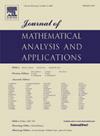IF 1.2
3区 数学
Q1 MATHEMATICS
Journal of Mathematical Analysis and Applications
Pub Date : 2025-03-18
DOI:10.1016/j.jmaa.2025.129498
引用次数: 0
摘要
在本文中,我们介绍并研究了 L2(R2) 中具有新型传输条件的拉普拉奇自关节变现系列,这些传输条件沿封闭的双利普西茨曲线 Σ 传输。这些条件包含了算子域中函数及其 Wirtinger 导数的 Dirichlet 迹的跃迁,并且是非局部的。通过构建方便的广义边界三元组,它们可以被 L2(Σ;C2) 中的所有紧凑自相关算子参数化。虽然对于所有参数选择,本质谱都是稳定的,并且等于 [0,+∞),但离散谱却表现出不同的行为。在许多情况下,离散谱是有限的,但我们也将描述一类参数,对于这类参数,离散谱是无限的,并在-∞处累积。后一类参数包含非局部版本的斜透射条件。最后,我们将把当前模型与最近在[33]中研究的相对论模型联系起来。本文章由计算机程序翻译,如有差异,请以英文原文为准。
Two-dimensional Schrödinger operators with non-local singular potentials
In this paper we introduce and study a family of self-adjoint realizations of the Laplacian in with a new type of transmission conditions along a closed bi-Lipschitz curve Σ. These conditions incorporate jumps in the Dirichlet traces both of the functions in the operator domains and of their Wirtinger derivatives and are non-local. Constructing a convenient generalized boundary triple, they may be parametrized by all compact self-adjoint operators in . Whereas for all choices of parameters the essential spectrum is stable and equal to , the discrete spectrum exhibits diverse behavior. While in many cases it is finite, we will describe also a class of parameters for which the discrete spectrum is infinite and accumulates at −∞. The latter class contains a non-local version of the oblique transmission conditions. Finally, we will connect the current model to its relativistic counterpart studied recently in [33].
求助全文
通过发布文献求助,成功后即可免费获取论文全文。
去求助
来源期刊
CiteScore
2.50
自引率
7.70%
发文量
790
审稿时长
6 months
期刊介绍:
The Journal of Mathematical Analysis and Applications presents papers that treat mathematical analysis and its numerous applications. The journal emphasizes articles devoted to the mathematical treatment of questions arising in physics, chemistry, biology, and engineering, particularly those that stress analytical aspects and novel problems and their solutions.
Papers are sought which employ one or more of the following areas of classical analysis:
• Analytic number theory
• Functional analysis and operator theory
• Real and harmonic analysis
• Complex analysis
• Numerical analysis
• Applied mathematics
• Partial differential equations
• Dynamical systems
• Control and Optimization
• Probability
• Mathematical biology
• Combinatorics
• Mathematical physics.

 求助内容:
求助内容: 应助结果提醒方式:
应助结果提醒方式:


